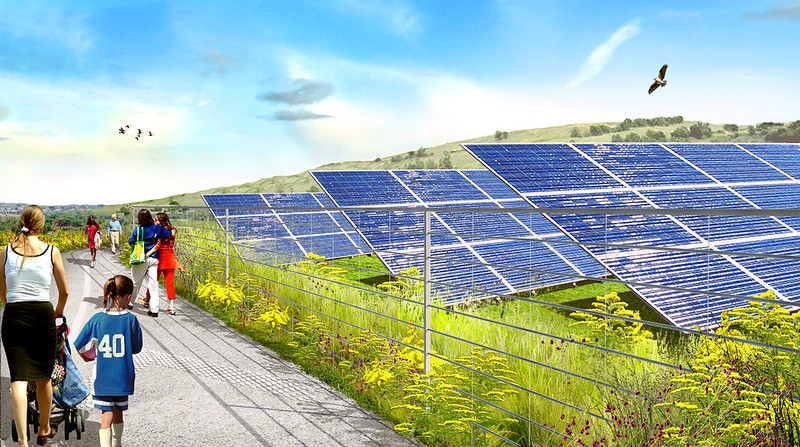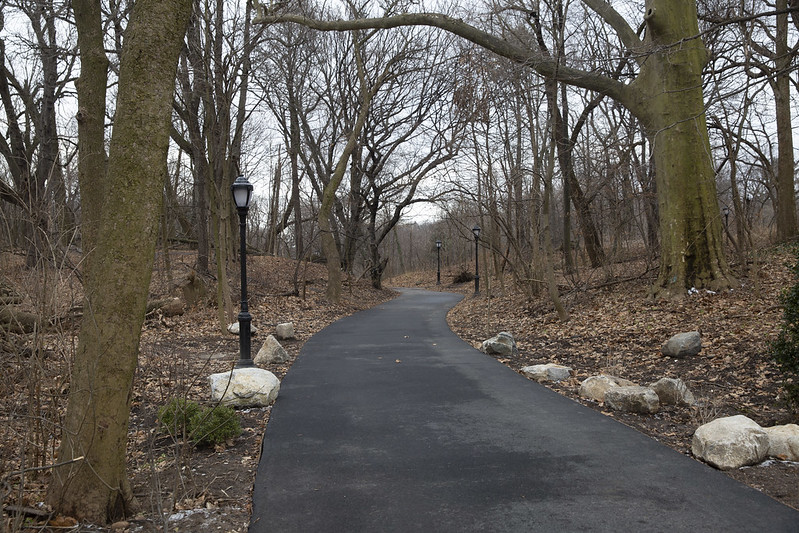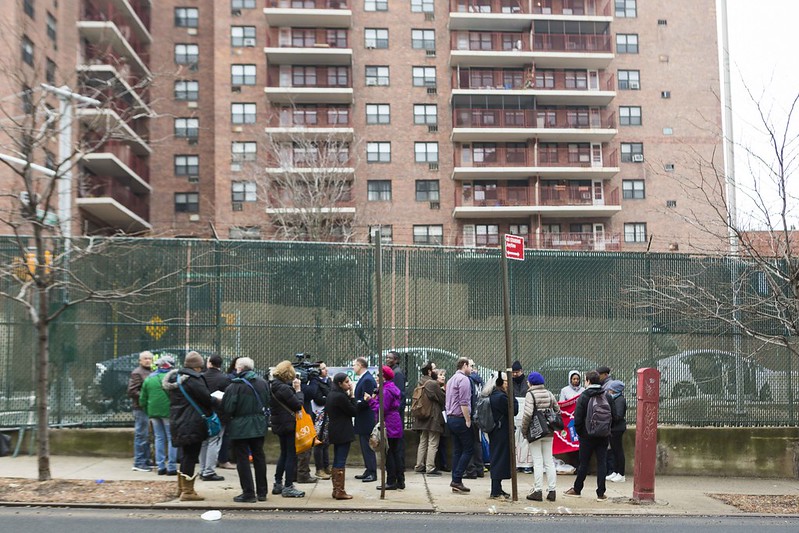A Key Step the State Must Take for New York’s Renewable Energy Future

Solar panels (rendering: NYC Mayor's Office)
In order to rebuild our economy and bring large-scale job creation back to New York in a post-COVID-19 world, we must turn our focus to renewable energy projects. These projects are the future; they are critical to building back up the state and delivering on New York’s nation-leading climate goals.
New York spearheaded national climate leadership by passing the Climate Leadership and Community Protection Act (CLCPA) in 2019, setting ambitious goals of net zero emissions by 2040 and 70% renewable electricity by 2030. In order for us to achieve these goals, New York must pass a standard tax assessment model for renewable energy projects.
What is a standard tax assessment model? As renewable energy projects like wind and solar are built, host communities negotiate property tax agreements through multiple jurisdictions like towns, counties, and school districts. The negotiations can take as much as two or more years.
By providing a standard methodology for assessing wind and solar projects, as proposed in Part X of the Revenue Bill in this year’s Executive Budget presented by the governor and included in the New York State Senate one-house budget last week, New York’s local communities and Industrial Development Associations (IDAs) will have a consistent framework on which to make decisions about taxation – all while ensuring local communities have the authority to support these types of renewable energy projects, opening the doors to achieving New York’s CLCPA goals.
That’s to say: New York State can unleash its pipeline of permitted and approved renewable projects and get them built. And at a time like this, the economic investment and job creation generated by renewable energy projects are imperative to rebuilding our economy and supporting the livelihoods of New York families.
With the governor and the State Senate on board, I urge the State Assembly to pass Part X. A standardized tax assessment model is critical to expanding wind and solar projects that will create thousands of prevailing wage-paying, union construction jobs—the kind of jobs that allow families to feel secure by earning consistent, fair wages and safety and health benefits.
Part X creates a win-win-win scenario for New York: it helps to facilitate the state’s nation-leading carbon reduction goals through the timely construction of solar and wind energy projects in the state; it promotes economic development through the creation of thousands of good-paying construction jobs; and it provides local gover nments with a uniform revenue stream.
Union labor has built New York to where it stands today. And we’ll keep building our great state into the future — a future that now revolves around renewable energy. Now it’s on the New York State Assembly to do its part to pass a standard tax assessment model for renewable energy projects. Doing so will put New York on track to meet our climate and clean energy goals while reinvigorating our economy – there’s no time to wait.
***
Vincent Albanese is Director of Policy and Public Affairs at the New York State Laborers’ Organizing Fund.
***
Have an op-ed idea or submission for Gotham Gazette? Email This email address is being protected from spambots. You need JavaScript enabled to view it.
Four ‘Simple’ Things We Can Do Now for a Greener, More Livable Community

Prospect Park (photo: John McCarten/City Council)
Recently, reading a book to my kids, we reached a point where the protagonist felt overwhelmed by too many challenges. “Cut it into smaller slices,” one of my twin six-year-olds wanted to suggest to the story’s hero, “like you do to my apple.”
From confronting our climate crisis to imagining how to reinvent our streets to be safe for my kids and all New Yorkers, the challenges can feel overwhelming. But what if we slice up this apple?
Greening our city — from livable streets to a sustainable future — can and must begin immediately. Big ideas that I strongly support such as the Green New Deal for New York City, require big, citywide policy changes, including state approvals; and areas of work close to my heart like investing in our parks and playgrounds, require citywide efforts. Yet there are plenty of actions we can start now at the neighborhood level.
The apple has already been sliced for us by dynamic and impactful non-profit groups in communities in Brooklyn, and around the city — and building on ideas from these groups, we’ve compiled a set of actions that, as I run for City Council in Brooklyn’s 39th District, I am ready to act upon to help create change at the neighborhood level: going big on rooftop solar energy; safer streets and pedestrian-first zones; reducing the carbon footprint of our food and waste; and accelerating the cleanup of toxic legacies in our backyard. These are actionable items to help those who call Park Slope, Windsor Terrace, Kensington, Borough Park, Gowanus, Carroll Gardens, Cobble Hill, and the Columbia Waterfront District home or who work, visit, or go to school there.
Solar roofs present a straightforward, win-win opportunity. The cost has been dramatically reduced, the technical issues have been solved, and we now have a number of installers with deep experience with New York buildings (including at least one company based in the 39th Council District).
What is now missing is an effort to put rooftop solar right in front of people’s noses. Big, transformative ideas like public renewable utilities and large-scale offshore wind are worthy, but will take time and require state approvals. All the tools to dramatically increase rooftop solar are available but need to be taken to scale: a door-to-door campaign to sign up for solar, a “public option” for community solar for renters, and financing tools to eliminate upfront costs. I’m especially excited about job training programs for solar installation as a pathway to the middle class.
There are just as many actionable ways to move forward on safer streets. I walk and bike with my kids around Brooklyn. My picture of a cyclist isn’t a super-athlete, it’s a parent ferrying kids, a delivery person, or my 76-year-old father who still criss-crosses the city on two wheels, with his new hip.
We need to transform how we protect our cyclists, strollers, seniors, and pedestrians—and how we reimagine public streets as public spaces. Our term-limited Council Member Brad Lander has shown that a local Council member can make a difference.
I’d build upon that track record by focusing enforcement and design solutions on the most dangerous intersections. I’d be a champion for going further to create and sustain public spaces for play, outdoor schooling, restaurants, culture, retail and community gatherings. In 2022, I’d work to make sure there is an on-going “open street” in each neighborhood and pilot a multi-block “pedestrians-first zone” in one neighborhood.
And let’s make it easier, more accessible and more affordable to get around our city—expanding Citi Bike throughout Kensington, each year rolling out a neighborhood bike network safe for ages 8 to 80, and invest in programs that make it easier for everyone to have and safely secure a bike.
We can immediately do better on waste and our food systems, areas where the last year has seen our city going backwards. It was a real blow to lose curbside collection of composting. I am grateful that community-based composting organizations rallied to preserve drop-off sites. But we can get the municipal program back on its feet in a cost-effective way through block-by-block outreach and complement it by making textile and e-waste recycling available to every block. At the same time, let’s pilot a containerization program on a commercial corridor to eliminate trash bag piles.
The cooperative economy also offers solutions. Food coops, mutual aid networks, and “buy nothing” groups provide a growing constituency to go to scale on reducing our consumer carbon footprint. I’ve spent two decades creating organizations that use social capital and collective effort to create big change and would help support and connect these newer and more established cooperative models to see what we really can accomplish together.
Finally, this isn’t limited to our district but there is a unique opportunity for us to go big on accelerating the cleanup of toxic legacies in our own backyard. The Gowanus Canal has been burdened by a historic legacy of toxic industry, with added pollution from combined sewage overflows (CSOs) into the canal from the city’s sewers everytime it rains. The work led by Rep. Nydia Velazquez and the EPA under the Superfund program deserves to be done as quickly as possible. Together we can move quickly on the city’s commitments to reduce CSOs and ensure sites are cleaned up to appropriate standards safe for residential uses.
And I recommit to the deal-breaker conditions for investment in NYCHA and environmental justice goals set by the Gowanus Neighborhood Coalition for Justice for any forward movement on the Gowanus Rezoning. Regardless of what happens with the rezoning, cleaning the Gowanus and supporting it as a vibrant, sustainable, and mixed-use neighborhood is a generational project that requires ongoing engagement and leadership.
As we’ve seen even in the worst of this pandemic, local partnerships can have impact faster than waiting for broader policies. One example: A group of neighbors and I came together to establish and expand the Camp Friendship Food Pantry last May, and we now serve hundreds of families each week.
As a City Council member, of course I would use local laws, land use review, and oversight as powerful tools — but to be truly effective, Council members also must use the soft powers of the office: convening local groups, providing a base for organizing around solutions, and bringing people together to solve problems. I’d build on my 20 years of experience as an organizer and institution builder to convene, innovate, and empower to make real headway on climate and safe streets in 2022, and contribute to greening our district, our city, and our future.
When the city began the curbside composting pilot, our building didn’t immediately qualify. I had to research the program, bring it to the co-op board and get buy-in. People were hesitant: Would it lead to more rats? A cluttered garbage area? What if we didn’t compost correctly? With the help of the organics program of the Department of Sanitation, we answered all these questions and opted in as a trial run.
Years later, when the city ended the program, several neighbors who had initially been hesitant came to me: “Justin, you know city government. How do we get composting back?”
The only way we do anything worthwhile: Together.
*Ideas in this column have been drawn from the tremendous work of a range of local organizations — culled from the public reports and programs and numerous direct conversations — including the Gowanus Neighborhood Coalition for Justice, Solar1, the Gowanus Canal Conservancy, BIG Reuse, The HOPE Program, Families for Safe Streets, Transportation Alternatives, the Riders Alliance, the Pratt Center for Community Development, Park Slope Neighbors, Sustainable CUNY, Lower East Side Ecology Center, and more that tackle these issues everyday.
***
Justin Krebs is a progressive organizer, leader of National Campaigns at MoveOn, and a Democratic candidate for City Council in Brooklyn’s 39th District. On Twitter @justinmkrebs
The State Assembly Must Step Up for At-Risk Families Like Mine

New Yorkers need housing (photo: Emil Cohen/City Council)
[Update: not long after this op-ed published, Assembly Speaker Carl Heastie tweeted the Assembly's support for the HAVP rental subsidy and indicated the Assembly majority he leads would be fighting for its inclusion in the state budget due by April 1]
I am the proud mother of an 18-year-old freshman at John Jay College, who is studying to become a criminal justice lawyer. It breaks my heart that he has to limit his opportunities and turn down potential jobs to prevent us from becoming homeless. That is the twisted logic of our state’s current rental assistance program — but it does not have to be this way.
This week I was heartbroken to see that Assembly Speaker Carl Heastie failed to include critical resources for homeless New Yorkers — namely the Housing Access Voucher Program (HAVP) — in the Assembly one-house budget. With over 92,000 New Yorkers homeless and dying from COVID-19 at astonishing rates, there is really no excuse.
I currently live in a two-family home on Staten Island with my children. We moved to Staten Island from New York City’s shelter system after fleeing a domestic violence situation that put me and my childrens’ lives at risk. I pay rent with what is called a “Family Homelessness and Eviction Prevention” (FHEP) voucher. My daughter and I both receive Supplemental Security Income (SSI) and we are eligible for rental assistance because of my son’s public assistance case. We are dependent on this income to pay our $1,534 monthly rent. My son wants to work and is able to work, but if he works more than 20 hours per week, his public assistance case will close, and we will lose our voucher and become homeless again.
Our landlords live below us, and our relationship has gotten worse over time. I am a constant target of their harassment and they have been trying to push me and my kids out onto the street in the middle of a pandemic. I am under incredible stress every day and it has taken a serious toll on my mental and physical health. I never feel safe – in fact, I feel like I am back in an abusive relationship all over again.
I have been trying desperately to move out of my apartment into a new place for the last 13 months, but the City will only cover $1,580 in rent for a family of three. This is what a studio apartment costs in New York City. I feel trapped: stuck in an unsafe apartment with rent I can’t afford; if my son gets a job I will lose the meager assistance I have but we want him to succeed.
My story is not unique. The alphabet soup I just described -- FHEPs, SSI -- might seem alienating to the average New Yorker. It’s alienating to me, too. But this is the cruelty of being homeless in New York: in order to get and keep public benefits, families like mine are forced to turn down opportunities, struggle in unsafe housing, and face byzantine processes that stop us from living a life with dignity every single day. And the vouchers still don’t cover rent to allow families like mine necessary flexibility.
HAVP is a stable rental subsidy that would help families like mine find permanent homes instead of moving from one bad situation to another. A program like this would change my life and the lives of tens of thousands of other people across New York State. It would pay fair market rent and challenge the status quo of current welfare programs that limit upward mobility by allowing my families’ income to increase until we are able to pay our rent independently. It would also cover undocumented people, as well people on social security and other fixed incomes — communities who currently have no rent support options.
There were 92,000 New Yorkers homeless before COVID-19 and if nothing changes that number is sure to grow. The New York State Senate has acknowledged that crisis, and included HAVP in their one-house budget proposal. But once again, the Assembly is leaving us behind. Without HAVP, the Assembly is leaving thousands and thousands of New Yorkers who have been at increased risk of exposure to COVID-19 and dying since the beginning of the pandemic. It’s shameful.
In order to recover from the pandemic, we need rental assistance for the homelessless. Along with it, we need to tax the wealthy (by passing the Invest in Our New York Act), make eviction protections like ‘good cause’ permanent, and forgive back rent. As homeless New Yorkers know best of all, Governor Cuomo is no friend. But Speaker Heastie must negotiate with Senate Majority Leader Andrea Stewart-Cousins and stand with us during final budget negotiations. Both houses have a supermajority. They should use it to create a budget that will sustainably fund our state out of this crisis and into a better future, making sure to finally take steps needed to address our homelessness crisis and help thousands of families like mine.
***
Gizel Garcia is a mother, and a young, ambitious, and disabled New Yorker. She is a leader in the Community Action Program at Neighbors Together, a community based organization located in central Brooklyn that organizes homeless and formerly homeless New Yorkers. She is an active leader with the Housing Justice for All campaign.
***
Have an op-ed idea or submission for Gotham Gazette? Email This email address is being protected from spambots. You need JavaScript enabled to view it.




